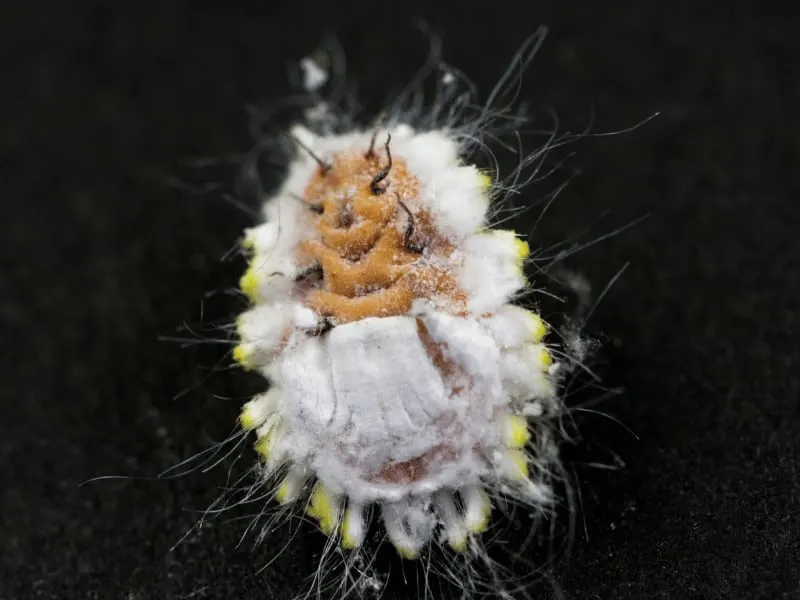Mealybugs in soil. It can be difficult to kill mealybugs infesting one of your plants. Mealybugs can be difficult to detect, so an infestation may be very advanced before you even realize what’s happening.
Unfortunately, I’ve learned from experience that it can be difficult to get rid of mealybugs without killing the plant.
However, I’ve used the methods listed in this article to safely and effectively eliminate mealybug infestations.
Table of Contents
Mealybugs in Soil
Hot water soaks, introducing a special species of beetle that preys on mealybugs, and mixing your plant’s soil with diatomaceous earth are some ways to deal with mealybugs. However, if these methods don’t work, throw the plant away to prevent the spreading of the infestation to other plants.

Methods for Getting Rid of Mealybugs in Soil
Hot Water Soaks
One safe and effective way to get rid of a mealybug infestation is to soak an affected plant’s roots in hot water.
Pull the plant out of its container, remove as much soil as possible, and soak the roots in 120-degree Fahrenheit water for about 10 minutes.
Clean the pot and repot the plant with fresh soil.
Mealybug Destroyers
Believe it or not, a beetle is called the “mealybug destroyer.”
The name is self-explanatory—these beetles are introduced to the soil of an affected plant, where they will quickly devour the mealybugs.
Spraying with Soapy Solution
Many people like to get rid of mealybugs with soap and water. The solution can be created by mixing water (1 gallon) with dish soap (2 tablespoons).
This solution should be sprayed on the plant and the soil it is in.
Drying Out the Soil
Mealybugs prefer moist soil, so drying out your plant’s soil can be an effective deterrent. However, be careful to avoid harming your plant.
I recommend this option only if your plant does not need that much water.
Exposing the Bugs to Cold Temperatures
This is another option that can be very effective but is also a little risky. If your plant can tolerate cold temperatures, exposing the bugs to these temperatures will kill both them and their larvae.
You can do this by putting your plant in a colder part of your house or outside (if the temperatures are cold outside).
Applying Rubbing Alcohol
Mealybugs can be killed with direct application of rubbing alcohol. They may even spread the rubbing alcohol to other mealybugs before they die.
Using too much rubbing alcohol, however, can harm your plant.
Mixing in Diatomaceous Earth
Diatomaceous earth is a type of insecticidal soil that kills mealybugs.
Many succulent growers always mix soil with diatomaceous earth to prevent mealybug infestations from happening in the first place.
This option is best for prevention rather than treating an active infestation.
Mealybugs are a Problem for Gardeners Worldwide
Mealybugs are a widespread species that cause problems for gardeners in many countries, especially gardeners who grow succulents.
Mealybugs are tiny insects that feed on the sap of various plants. They are about one-tenth of an inch long and usually white or yellow.
It can be difficult to discover a mealybug infestation until the plant is in bad shape because mealybugs usually live below ground in the plant’s root ball.
In addition to succulent plants, mealybugs can trouble flowers like violets and geraniums.
The Damage that Mealybugs Cause can be Catastrophic
Mealybugs are parasites that eat a plant’s sap, which means they are effectively sucking the plant’s blood. They suck the sap straight from the roots into their stylets (mouths).
In small numbers, mealybugs aren’t much of a threat to plants. They even leave behind a pleasant-sounding residue called “honeydew.”
Despite its pleasant name, honeydew can cause mold to grow on the plant’s roots.
While a small mealybug infestation is not likely to harm an otherwise healthy plant, mealybugs reproduce quickly. This means that a few mealybugs can turn into thousands of mealybugs in a week or two.
At this point, the honeydew left behind by the colony of mealybugs will cause such a large amount of mold on the plant’s roots that it will suffer from rot.
Rot can quickly kill plants that were healthy only a few weeks before. An infestation can also spread between plants.
Frequently Asked Questions
What should I do if I can’t get rid of a mealybug infestation?
If you have tried several of the methods listed above and the infestation has not been eliminated, you must throw away the plant. This is necessary because a mealybug infestation can easily spread to other plants.
How can I prevent a mealybug infestation in the first place?
As previously mentioned, mixing diatomaceous earth with your plant’s soil can prevent a mealybug infestation. It’s also crucial not to overwater your plants.
Conclusion
Dealing with mealybugs in soil can be a learning experience. After you have experience dealing with a few mealybug infestations, you will become much better at detecting and eliminating them.
You can also use these skills to eliminate infestations from other kinds of bugs.

Daniel has been a plant enthusiast for over 20 years. He owns hundreds of houseplants and prepares for the chili growing seasons yearly with great anticipation. His favorite plants are plant species in the Araceae family, such as Monstera, Philodendron, and Anthurium. He also loves gardening and is growing hot peppers, tomatoes, and many more vegetables.


